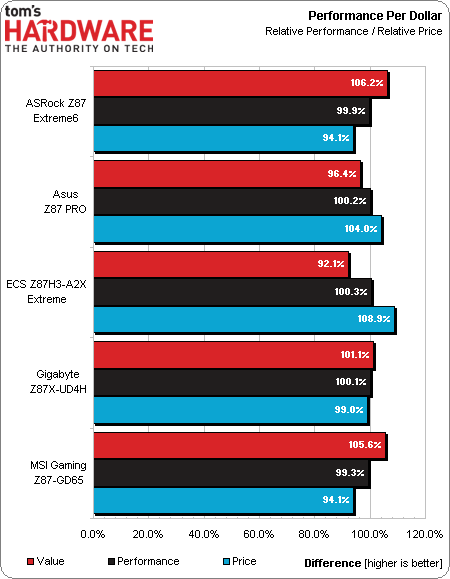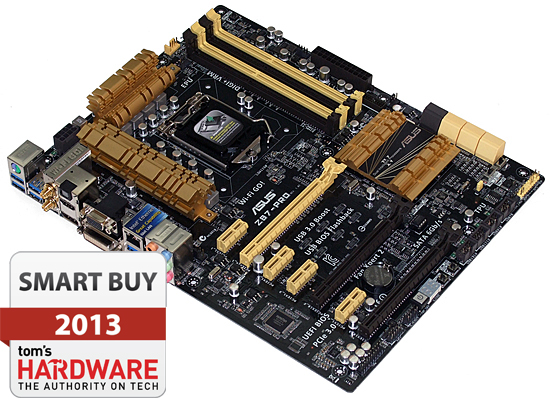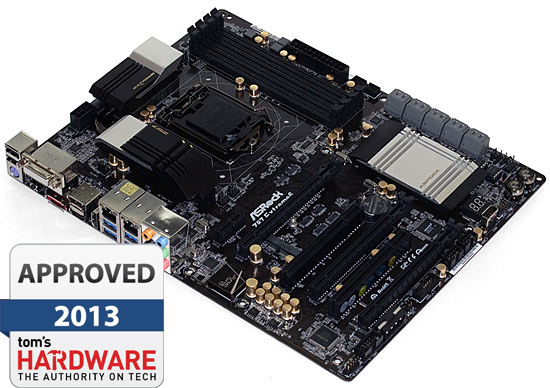Five Z87 Motherboards Under $220, Reviewed
Intel’s Haswell architecture displaces Ivy Bridge in its desktop line-up, bringing with it yet another new CPU interface. We tested six motherboards that claimed to be ready for your overclocking efforts, and included the five survivors in today’s review.
Picking Our First Z87-Based Winner
Why you can trust Tom's Hardware
Asus and Gigabyte sent us the two top overclocking motherboards in today’s round-up. And with performance essentially equal between all candidates, it would be easy for me to simply award those two products first and second place. Doing so wouldn’t account for differences in features and price, however.
ASRock let us know that its motherboard would sell for $220. Yet, when the product launched, it was $190. The original $220 price was reserved for a Wi-Fi-equipped version of the same product.
At the other end of the pricing scale, ECS matches ASRock’s dual networking capability in a fashion, though its network controllers are slightly-less expensive Realtek models. ASRock uses Intel. These two boards would also be equally priced if ASRock hasn't implemented a last-minute price drop. ECS improves its lot with low-cost Wi-Fi and Bluetooth controllers. ASRock only beats ECS as long as the Z87 Extreme6 sells for less than $200.
MSI’s Z87-GD65 Gaming can be purchased for $190, and we have no doubt the company will maintain its pricing structure. We believe it’s a slightly higher-quality product as well, though it’s impossible to overcome the fact that it offers fewer features.
The Asus Z87 Pro roughly matches ASRock’s apparent feature value by adding a fairly good Wi-Fi and Bluetooth solution. Higher stability, quality components like 5,000-hour-rated capacitors, and less conspicuous features (such as its USB BIOS Flashback IC) probably make up for its $20 price premium. We’re not afraid of radical price shifts from Asus; the company's prices usually go down following a launch. And those factors come together, making it easy for us to give the most stable motherboard in this round-up our stamp of approval.
Let’s also not forget that Asus is the only firm to accurately report DIMM voltage. Anyone who still sees a tie here might want to knock a couple of percent off of everyone else’s score after re-reading our firmware analysis pages.
Update (6/4): ASRock's Z87 Extreme6 Drops Again!
ASRock’s preemptive strike against pricing incredulity is to apply yet another $20 discount on top of the already-discounted price discussed above. That drops its Z87 Extreme6 to $170. Although I had to reserve any award for a $190 Z87 Extreme6 that might have shot back up to $220, a $170 price that might shoot back up to $190 makes me a lot more confident about the Z87 Extreme6’s high value.
We’re holding ASRock to this $170-$190 range for the next month as we prepare our next round-up.
Update (6/11): Gigabyte's Z87X-UD4H Surfaces (Or Was It There All Along?)
Number two in overclocking stability, Gigabyte’s Z87X-UD4H originally looked like a great product at too-high of a price. But the company claims to have known something we didn't: the board was available all along at Micro Center for $185. Compare the launch-day price of $190 for ASRock's Z87 Extreme6. As enthusiasts, we usually favor overclocking features over secondary network controllers. Gigabyte's question is whether it was more deserving of a value award on launch day. We answer with a resounding “Probably”. But the Micro Center price didn't show up in any of our searches before this round-up went live, and we have confirmation from Gigabyte that it won't be available elsewhere until next month. Without a way for us to verify Micro Center’s price history, we simply can’t know for sure.
What we do know is that hours before we published this article, ASRock’s Z87 Extreme6 price dropped to $170. Though a $185 Z87X-UD4H might have taken the value award ahead of a $190 Z87 Extreme6, ASRock’s price drop probably would have forced us to issue a matching award for both the Z87 Extreme6 and the Z87X-UD4H. We don't issue or retract awards retroactively though, so that point is now moot. Regardless, whether Gigabyte's attractive price at Micro Center is long-lived or a more recent development, the board now gets our recommendation as a top-value overclocking alternative.
Get Tom's Hardware's best news and in-depth reviews, straight to your inbox.
-
Someone Somewhere Who did you get the CPU from? Given the Haswell launch article said they were unlikely to be able to hit 4.5GHz+, is this a cherry-picked chip from Intel?Reply
Could we see some MBs around the $130-$140 mark? They're the interesting ones IMO, and would toast most of these in terms of value. -
Crashman Reply
Intel says it doesn't cherry-pick chips for reviewers...10911132 said:Who did you get the CPU from? Given the Haswell launch article said they were unlikely to be able to hit 4.5GHz+, is this a cherry-picked chip from Intel?
-
Memnarchon Thank you. I was looking forward for a review like this. I read some reviews and the o/c was varying from mobo to mobo lot. So if the same cpu was used, 4,3Ghz to 4,7Ghz is a lot of difference. Because if your cpu would o/c to 4,3Ghz most we would tell its a crap sample Haswell sucks on o/c etc etc, but if it was be able to clock to 4,7Ghz we would say its a nice sample.Reply -
cangelini Reply
Yes, the CPU comes from Intel. Almost certainly it was cherry-picked. But this is why we didn't rely on these CPUs for our launch coverage--it makes a lot more sense to go to a source with hundreds of boxed processors on the bench to get a real sense for what Haswell will do in the wild. At least for this round-up, the variable changing is the motherboard. So, we derive as much meaning as possible with a review sample that hits 4.7 GHz on one board and 4.5 GHz on another.10911132 said:Who did you get the CPU from? Given the Haswell launch article said they were unlikely to be able to hit 4.5GHz+, is this a cherry-picked chip from Intel?
Could we see some MBs around the $130-$140 mark? They're the interesting ones IMO, and would toast most of these in terms of value.
-
Someone Somewhere Yeah - but if people think that their chip is going to hit 4.7 on a good board, then find they can't get 4.5, they can be upset.Reply
OTOH, the launch coverage said that was at 1.2V, while this is 1.3V, so I guess a few hundred MHz extra is reasonable.
Lot more variation than on IB's review: http://media.bestofmicro.com/X/O/335580/original/image019.png -
JOSHSKORN Isn't there a flaw in the Z87 technology regarding sleep mode? Was it mentioned in the article? I didn't see it.Reply -
Jason Louie do these board suffer from the rumoured usb3 sleep issue? or are they the fixed B3 steppings ?Reply -
Crashman Reply
Did you read the Haswell review? All current boards are affected, no future boards will be, there's nothing to update here, and the flaw is virtually meaningless.10911218 said:Isn't there a flaw in the Z87 technology regarding sleep mode? Was it mentioned in the article? I didn't see it.
http://www.tomshardware.com/reviews/core-i7-4770k-haswell-review,3521-9.html
If you have one of the affected drives and can't be bothered to reconnect it when it goes offline, wait a couple weeks and buy a board from the new batch.
The differences between boards in today's review are overclocking, power consumption, and onboard features. None of those things will change with the new PCH batch, and firmware updates should improve both batches equally.
-
Jason Louie do these board suffer from the rumoured usb3 sleep issue? or are they the fixed B3 steppings ?Reply -
sna Hello,Reply
Can you guys please test 6 SSD in Raid 0 on these mobos ? this is the only Advantage of upgrading to a Haswell over ivy/sandy bridge.



